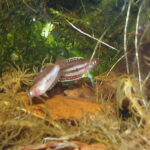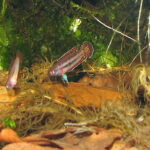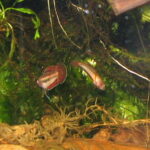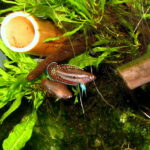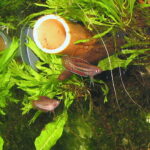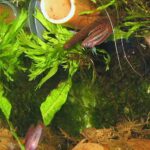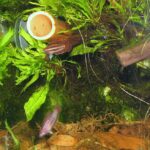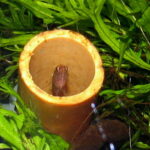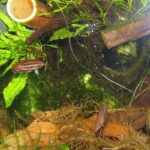Kottelat & Nd 2005
First description: Diagnoses of six new species of Parosphromenus (Teleostei: Osphronemidae) from Malay Peninsula and Borneo, with notes on other species. The Raffles Bulletin of Zoology 2005 Supplement No. 13: 101-113.
Characteristics: total length max. 4.0 cm. Fin formula: Dorsal: XII-XIV, 7-7, total 19-20, anal fin: XIII-XIV, 6-9, total 20-22. Both partners have spotted unpaired fins and 0-3 (often 2) consecutive black spots on the body sides; this resembles P. linkei. Besides these, only some variants of P. paludicola show these spots. However, the caudal fin of the male has no filament like linkei, but it is rounded as it is in females. The distinction between sexes can thus be difficult, especially because the coloration pattern of the unpaired fins is similar in both sexes: in full extension silver-white speckles on brown-red to bright red background without the fluorescent bands, which are typical for licorice gouramis.
Only narrow whitish lines appear on the edges of the fins. The fin coloration of the males is more distinct and colourful compared to the females and the dorsal fin is more pointed. These features are recognisable already in sub-adult fishes.
Similar species: due to the particularities in structure and coloration in both sexes the risk of confusion is low. Couldn’t be confused with red-finned linkei, because of the speckled unpaired fins and lateral spots. In contrast to this species, P pahuensis always shows a round caudal fin without a filament and never a zone of red dots, as it can be seen in some P. linkei.
Occurrence / Distribution: P. pahuensis inhabits the streams in the catchment area of the Mahakam River in the eastern lowlands of Borneo (Kalimantan Timur). This area is mostly less developed then other parts of the island. The type locality is situated downstream beyond the village of Muarapahu – this name was given to the species. The first known habitat of occurrence near Melak had a pH around 5.0, a low residual hardness of 3 degrees and a temperature of about 27°C. Another area of occurrence had similar values. Although the genetic proof is still pending, it can be assumed that these local forms are variants of the same species: P. pahuensis.
Threat: Kalimantan Timur still features remnants of the natural vegetation; more then the adjacent areas in the west, K. Tengah and K. Barat. However this area is increasingly threatened by melioration and agricultural use. Therefore this species is endangered as well despite its eastern distribution.
Discovery/First import: given its remote distribution, pahuensis was discovered relatively late: in 1996 Dickmann, Grams and Knorr discovered the fish near Melak. They were also called spec. Jantur Germeruh or, in the German first description, “Honeymonn Licorice Gouramis”. The fish was found at a second locality, Jengan Danum, too. The first successful breeder was G. Kopic (D), but the descendants of these first known fishes disappeared soon afterwards. Only in 2007 did the Japanese “Team Borneo” (H. Kishi et al.) rediscover the fish during an expedition in Kalimantan Timur.
Trade: until recent years, the species apparently never appeared in trade, but it was distributed in small numbers privately in Japan and Europe. In 2009, when H. Linke received some fish from H. Kishi from Japan, bred them and passed them on to P. Finke and others. Today the species is occasionally offered by some ex- or importers, though this is extremely rare (e.g. in 2011 in D and GB).
Care / Breeding: like other licorice gouramis, although obviously it is not as tolerant and relatively undemanding as its “sister”-species linkei. Thus it is not a beginner’s fish for newbie’s in the licorice gourami hobby. Attention to the typical values for the water has to be paid. Sometimes it is very difficult to breed them, in other cases breeding goes faster than expected. Up to now, there is only little experience with the species.
Behaviour / Particularities: Head-down or horizontally courtship. Standard caves of all kinds are accepted.
Literature:
Weblinks:


